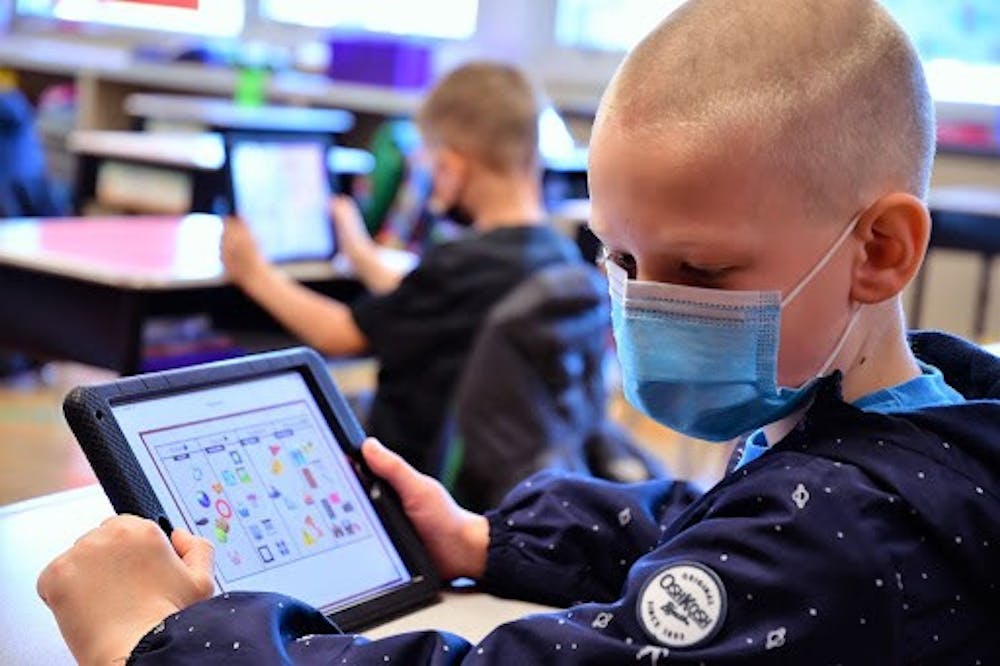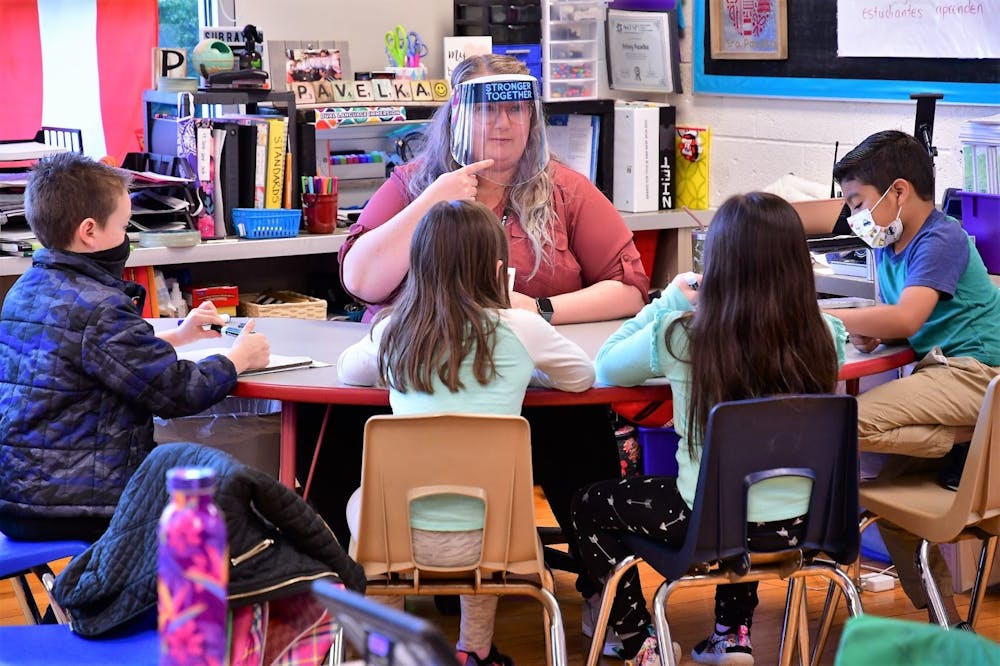How to enroll students in the Dual Language Immersion Program
Parents can enroll their students into the program in either kindergarten or first grade. West View Elementary School currently has a capsize of 25 students per classroom, but additional students can be put on a waitlist.
Dual language teacher Kelsey Pavelka said, before the pandemic, the waitlist had grown three times since the beginning of the program in 2017. However, many students opted out of the program after moving to remote learning. Pavelka said classrooms have openings as of right now.
Source: Kelsey Pavelka, dual language teacher at West View Elementary School
Editor's Note: This story is part of The Partnership Project, a series of content written in an effort by The Daily News to follow the formal collaboration of Ball State University and Muncie Community Schools. Read more in this series here.
Vibrant colors of orange, yellow, green and red cover the walls from floor to ceiling in forms of flags, posters and papel picados. Cubbies line the walls and desks are spread out like a typical elementary school classroom, but, sticking true to the program, there are hardly any English words displayed. Instead, they are replaced by a buzz of activity from the teacher reading in Spanish to the excited chatter of the students. This is what it’s like to walk into Kelsey Pavelka’s elementary dual language immersion classroom.
Almost every day, students in Pavelka’s first grade class at West View Elementary School gather in small groups to practice their Spanish with one another using flash cards and white boards during the Spanish Language Arts time.
Andrew Triplett, 8, said this is his favorite part of the day. It helps him build his vocabulary skills, which he can use to compare with his family at home for fun.
“I know a little bit more Spanish than my mom,” he said. “I’ve been here a long time.”
West View introduced this language immersion program for kindergarteners in the 2017-18 school year and has added one grade to the program each year. Currently, the program is offered for students in kindergarten through third grade.
Triplett’s sister is also involved in the program, and he said it is great for her because she has made many new friends. Like his sister, Triplett has made friends in the program, too. One of them, Kate Zick, 7, said her favorite part of the day was learning math in Spanish.
Triplett said he liked this, too, and it has inspired him for his future career.
“I want to help people who don’t know that much math,” Triplett said. “I want to be a teacher and a cop and a firefighter. I just want to help people.”
The future seems bright for many of the kids in Pavelka’s class. She’s been with the program since its second year, she said, and has loved watching her students grow with it.
“It’s truly amazing to see how much these kids are able to absorb,” Pavelka said. “You can really see in a year how quickly they are able to push themselves.”
West View Elementary School is now on to its fourth year with the Dual Language Immersion Program. According to the Muncie Community Schools’ (MCS) website, the program is “an in-depth English-Spanish curriculum that begins in kindergarten, enabling students to develop proficiency in both languages.”
West View is just one of 32 schools in the state of Indiana that offers a dual language program, greeting guests as they walk through the front doors with signs reading “Welcome” and “Bienvenidos.”

Owen Roberts sits in Kelsey Pavelka's class, April 16, 2021, in West View Elementary School. Roberts is a student in the Dual Language Immersion Program. Andy Klotz, Photo Provided
West View’s website says the school has three main goals of the program: bilingualism and biliteracy, high academic achievement and sociocultural competence.
To implement this, the school follows an 80-20 system, meaning 80 percent of the classes are taught in Spanish and 20 percent in English. Students still learn math, science and social studies, but some of the classes are taught in a different language.
“Teaching in Spanish is different from teaching Spanish,” Pavelka said. “It’s a lot of work.”
She spends the first 80 percent of the day with her students going through math, Spanish Language Arts and Project Lead the Way activities.
The last hour and a half of the day is spent entirely in English, starting with the students' “specials” before they start a time called “bridge.” During this period, the teachers focus on sharing with their students their brains have two different sides that help make connections between the two languages.
“There’s a Spanish side and an English side,” Pavelka said. “During the ‘bridge’ part of the day, we are helping them to build a bridge from what they know in Spanish to what they know in English.”
For Pavelka, building the “bridge” is a process. She said all the students struggle at different rates because they aren’t expected to be fluent after one year. Pavelka said this is a common misconception parents have when enrolling their children into the program.
One example she used was not to expect children to order from a Mexican restaurant after one year in the program. In fact, students are taught they aren’t supposed to be learning how to translate things, she said. Their brains do it on their own, and it comes with time and practice.
Chin-Sook Pak, Ball State Spanish professor, is passionate about these programs and stressed the benefits research has found of dual-language learning.
She said one benefit is students will perform better than their peers in a monolingual environment because they are more cognitively challenged, and this allows their brain to further develop. Another benefit, Pak said, is dual-language learning allows them to naturally be more aware and flexible when working with diverse and cultural groups.
Further down the road, Pak said, this can help students to be more adaptable in a global market.
“In a well-designed program, the end goal is to produce true bilinguals while aiming for academic excellence and reap benefits of increasing intercultural appreciation,” she said.
It’s even beneficial for students at Ball State University, Pak said. Two of her Spanish classes have completed immersive projects while collaborating with the program.
Spanish 305 is an advanced grammar class for Latino students at the university, which held a 10-week virtual reading session for the elementary students. Pak said the emerging learners were able to read and communicate in Spanish.
“It was great because students were able to see role models who were all Hispanic,” Pak said.
Another class, Spanish 404, created the promotional booklet that can be found on the MCS website.

Benjamin Kimmell sits in Kelsey Pavelka's class April 16, 2021 in West View Elementary School. The dual language classrooms teach math, science and social studies, but 80 percent of these subjects are taught in Spanish at the elementary level. Andy Klotz, Photo Provided
Pak also said it is important these programs are implemented more around the United States.
“[In] the rest of the world, the bilingual population is 50 percent depending on the source,” she said. “Only 20 percent of [the United States] population is bilingual, so we are not really keeping up.”
More than 18 percent of the U.S. population identifies as Hispanic or Latino, and that number continues to grow, according to the U.S. Census Bureau. The Census Bureau also states more than 13 percent of the population speaks Spanish at home.
Spanish is the second most used language in the country, and Pak said she believes this is important to consider in educating children.
“When kids start school and their home background is not respected and valued and utilized, students do not do as well academically because, at school, part of their identity is denied,” Pak said.
The number of dual language schools has grown in the last few years with help from government-funded grants. 35 states now offer Dual Language Learning Programs, however, there are some setbacks to adding more.
One setback, Pak said, is there are not enough bilingual teachers. This is something Pavelka and MCS are continually working on because they are planning to extend the current program through high school.
Next year, students entering the fourth grade will transition to a 50-50 model for the first time, meaning half of their day will be in Spanish, and the other half in English. This model would follow them through the rest of their middle and high school careers.
Another setback of adding more dual language programs, Pak said, is hesitancy from parents who are afraid their children will fall behind their peers being taught in a traditional, monolingual classroom. Plus, the COVID-19 pandemic halted classroom visits with families.
For those who question dual language schools, Pavelka has two pieces of advice: do the research and trust the process. She said she feels grateful for parents who choose to enroll their children.
“They are trusting us with an immense responsibility to educate their students in a way that they themselves are not capable of doing,” Pavelka said.
This trust, she said, can be felt every day. Pavelka said she believes the benefits of dual-language learning outweigh the fears.
West View staff continues to look to the future with hope for the program and its students. It’s preparing kids to walk out of school ready for the world, whether they dream of being a lifeguard like Kate or a teacher, cop and firefighter like Andrew.
Contact Natasha Leland with comments at nleland@bsu.edu or on Twitter @leland_natasha.





